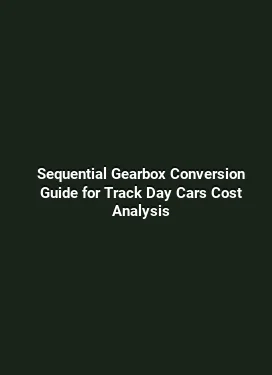How to Install Quick Release Steering Wheel with NRG Hub Adapter
Choosing the Right Quick Release System for Your Vehicle and Drivetrain

Upgrading to a quick release steering wheel can enhance track responsiveness and ease of cockpit access, but a successful installation hinges on selecting a system that suits the vehicle’s steering column, steering shaft spline count, and overall drivetrain layout. The NRG hub adapter is a popular choice because it provides a reliable interface between a broad range of steering wheels and the factory or aftermarket steering shafts. When evaluating options, consider spline compatibility, overall diameter, bolt pattern, and the hub’s ability to maintain proper wheel centering under load. A well-matched setup reduces play, ensures precise input transfer, and preserves the integrity of steering column components during aggressive maneuvers. A practical approach begins with identifying the vehicle’s existing steering wheel size, the spline count on the steering shaft, and whether any airbag or wiring harness remnants will influence the installation. For road cars, a snug, well-centered wheel improves daily driving feel, while race-oriented builds demand precision alignment and reliable clamp force to handle high g-forces. It is important to assess whether the car’s electrical system includes an airbag module that must be deactivated or handled in compliance with local regulations. In some applications, a spacer or a custom adapter may be necessary to achieve the desired wheel position and reach, especially in vehicles with tight cockpits or non-standard column geometries.
Key factors include the hub adapter’s construction material, typically billet aluminum or steel, and the mounting hardware’s torque tolerances. A high-strength, properly torqued assembly minimizes vibration and movement under load. Compatibility with quick-release rings, locking mechanisms, and the possibility of maintaining steering angle sensors or wiring harness continuity should also be verified. The drivetrain’s role in steering input transmission means ensuring that the installation does not introduce excessive play in the steering column or alter the steering ratio in a way that could compromise handling dynamics. Compatibility checks and careful planning set the stage for a clean, repeatable installation that respects the vehicle’s drivetrain architecture.
Preparing the Vehicle: Tools, Safety, and Workspace Layout
Before touching the steering system, create a clean, well-lit workspace with ample room to maneuver the wheel and spare parts. Gather essential tools: a torque wrench with a calibrated range suitable for fasteners on the hub adapter, hex keys or socket set tailored to the specific mounting bolts, a trim removal tool to access airbag or dash connectors, screwdrivers, alignment marks, and thread locker if recommended by the hub manufacturer. A magnetic tray helps organize small fasteners, while a pair of gloves reduces the risk of skin irritation when handling metal edges or wiring harnesses. Safety is paramount; disconnect the vehicle’s battery and wait for any residual energy in the airbag system to dissipate following the manufacturer’s recommended wait time. If the car is equipped with a driver’s airbag, consult service documentation to determine whether a short-term deactivation or a professional removal is required. Layout planning includes mapping out the routing path for any steering column wires, horn circuits, and airbag connectors. Identify whether the steering wheel will re-use the original ignition/clock spring assembly or if the hub adapter requires a different connector arrangement. It is also wise to check the steering column for any signs of wear, such as a wobbly yoke or visible shaft play, which could magnify once the wheel is detached. Any pre-existing movement in the column should be addressed before installing the quick release system to prevent misalignment or bind during operation.
With the workspace prepared, perform a visual inspection of the existing steering wheel and hub area. Note the seat position and wheel reach to ensure that the new wheel does not obstruct dashboard controls or pedal geometry. A temporary alignment setup can help verify clearance before final assembly. If you plan to use a retractable or fixed steering wheel, confirm that the chosen option aligns with the vehicle’s ergonomics and the driver’s line of sight. Maintaining a consistent, distraction-free work environment reduces the chance of misplacing fasteners or damaging sensitive components during the installation process.
Disassembling the Original Wheel and Accessing the Steering Shaft
The disassembly phase centers on removing the existing wheel with care to preserve the horn button, airbag housing, and electrical connectors. Start by removing the center nut or retaining bolt that holds the wheel to the steering hub. If an airbag is present, follow the specific procedure to release the module and detach the airbag connector safely. Use a non-conductive puller or a suitable tool to avoid bending the clock-spring ribbon or damaging the horn switch. Once the wheel is detached, clean the area around the steering column and inspect the splines on the shaft for wear or rounding. Damaged splines can compromise the new adapter’s grip and wheel alignment, so replacing the shaft or hub may be necessary in extreme cases. With the wheel removed, the next step is to detach or accommodate the clock spring if the hub adapter requires direct access to the shaft. Some hubs intercept the clock spring assembly, enabling the wheel to rotate freely while maintaining electrical continuity for horn and other controls. In vehicles with an integrated airbag wiring harness, ensure that the harness is safely bundled and that no wires are pinched by the adapter. At this stage, it is prudent to compare the original steering wheel’s mounting pattern and hub dimensions with the NRG adapter’s specs to confirm compatibility and reduce the risk of misalignment after installation.
Careful labeling of wires and connectors during disassembly pays dividends during reassembly. Photograph each connection and note any color-coded or function-specific pins. This documentation becomes a reference point when reattaching the wheel and ensures the horn, cruise control, and other functions operate as intended once the new wheel is in place. The disassembly process is a crucial checkpoint for drivetrain integrity, because even minor misalignment can alter steering feel and response, especially during high-load cornering where drivetrain components transmit forces through the steering assembly.
Mounting the NRG Hub Adapter: Alignment, Torque, and Centering
The NRG hub adapter acts as the critical interface between the steering wheel and the steering shaft. Begin by aligning the adapter’s spline pattern with the steering shaft to ensure a perfect match. Many adapters feature a keying system or set of alignment marks to simplify this step. Slide the adapter onto the shaft and verify that it sits flush against the steering column housing with no gaps that could introduce wobble. If a spacer is required to achieve the correct wheel position, install it now, ensuring the spacer does not interfere with the clock spring or wiring harness routing.
Attach the hub using the manufacturer’s recommended bolt configuration and torques. It is common to use a star or cross pattern to achieve uniform clamping force across all mounting points. Apply thread locker if specified by the hub’s instructions and torque the fasteners to the stated values using a calibrated torque wrench. The goal is to achieve a crisp, no-gap interface that minimizes play while protecting the shaft splines from binding or shearing under load. After securing the hub, verify wheel centering by rotating the steering wheel from lock-to-lock and confirming there is no rubbing against dashboards, wiring, or horn assembly. Any misalignment caught at this stage should be corrected before proceeding to wire connections and final assembly.
Centering the wheel is especially important for high-performance applications where precise input mapping matters. Use alignment marks on the hub and wheel to verify that the wheel sits perfectly vertical and parallel to the dashboard surface. Minor off-center adjustments can be made by loosening the mounting bolts slightly, rotating the wheel to the desired orientation, and retightening in the correct sequence. This step reduces the risk of steering wheel pull or uneven feel in the center position, a common symptom when centering is off by even a small amount. The hub’s design should inherently support maintaining center alignment once torqued properly, but careful re-checks during the first test spins are essential for safe operation.
Wiring, Horn, and Optional Accessories

Wiring the horn and any optional accessories—such as paddle shifters or driver controls—requires careful routing to avoid interference with steering movement. If the wheel uses integrated switches or a mode selector, ensure that wires are long enough to accommodate full steering lock without stretching. Use loom or protective sleeves to shield wires from abrasion against the hub or wheel spokes. In cars with airbag systems, reconnect the horn and any required airbag harness following the vehicle’s service manual. If an airbag is permanently deactivated, follow local regulations for safe disposal and labeling to prevent accidental deployment during service or transport.
The clock spring is a critical component for preserving electrical continuity of steering column circuits during rotation. If the hub adapter interface bypasses or integrates with the clock spring, verify the wiring path and confirm that no additional resistance or signal loss occurs. A clean, organized harness layout reduces the potential for electrical faults and ensures reliable horn and control functionality under dynamic driving conditions. After completing the wiring, perform a function check: horn press, turn signals, and any steering wheel-mounted controls, followed by a short, low-speed test drive to verify that nothing binds or rubs during operation.
Testing, Calibration, and Drivetrain Feedback
With the installation complete, a structured test plan helps validate the upgrade across a range of conditions. Begin with a static check: confirm wheel centering, alignment, and that the quick-release mechanism engages and disengages smoothly. Next, perform a controlled low-speed maneuver to ensure the wheel returns to neutral without any binding or slack. Incrementally increase speed and perform gentle cornering to feel for any unusual vibration, wobble, or drift that may indicate misalignment or inadequate fastener torque. In high-load situations, such as track driving or spirited street driving, the drivetrain transmits torque through the steering column more aggressively, so the hub must maintain rigidity and precise contact with the shaft under these conditions. If any abnormal feel arises, revisit alignment, torque values, and wiring installations before proceeding to more demanding trials.
Advanced calibration steps may include re-checking steering ratio and feel with the new wheel across a full range of motion. Some drivers prefer a slightly shorter or longer wheel to tune the overall steering response, which can affect how the drivetrain communicates with the driver. While many systems provide a consistent feel, minor adjustments—such as changing wheel diameter or adding a different grip thickness—can influence how effectively the driver can modulate steering input without overcorrecting. The objective is a harmonious interaction between the wheel, hub adapter, and the steering column that translates intent into precise drivetrain response without introducing undesired play or delay. Regular maintenance, including re-torque checks and visual inspections of the hub and wiring harness, helps sustain performance over time.
Common Pitfalls and How to Avoid Them
Several recurring issues can undermine a quick-release installation. First, mismatched spline counts or incompatible bolt patterns between the wheel, hub, and column can create gaps and alignment errors. Always verify compatibility across all components before purchasing. Second, inadequate torque on the hub bolts or improper star-pattern tightening can allow wheel play to develop under load, diminishing steering precision. Third, failure to manage wiring harnesses properly may cause electrical faults or harness wear due to contact with moving parts. Finally, neglecting to disassemble or reconnect airbag modules according to safety guidelines can pose risk of accidental deployment or non-compliance with safety regulations. A proactive verification approach—checking fitment, torque values, wiring routing, and safety compliance—reduces the likelihood of post-install issues and ensures a reliable upgrade that enhances drivetrain feedback and control.
In practical terms, always plan for a test drive in a controlled environment. If possible, perform the initial drive on a closed course or empty parking lot to build confidence in the new setup. Use this opportunity to assess steering feel, return-to-center behavior, and any influence on pedal geometry or cockpit ergonomics. Document your findings and adjust as needed. A well-executed installation integrates the quick-release wheel with the vehicle’s drivetrain in a way that preserves safety, reliability, and the driver’s tactile connection to the road.
Maintenance and Longevity of the Quick Release System
Maintaining a quick-release steering wheel, hub adapter, and associated components is essential for sustained performance. Regularly inspect mounting bolts for signs of loosening and re-torque to the manufacturer’s specifications on a schedule appropriate for your driving conditions. Check the hub’s locking mechanism for smooth operation; if the release feels stiff or gritty, clean and lubricate according to the product guidance, ensuring any lubricant is compatible with metal-to-metal contact and does not attract debris. Inspect the steering column area for signs of wear around the spline interface, as excessive wear can degrade centering and stability. If any wear is detected or if the quick-release ring shows signs of deformation, plan a replacement to prevent potential failures during operation. In endurance or regularly track-driven setups, more frequent checks are advisable due to higher thermal and load demands on the hub and wheel interface.
Additionally, consider the impact of weather and storage on the wheel and hub assembly. Protect components from exposure to corrosive elements by storing the wheel and hub in a dry environment and using appropriate seals or covers when not in use. For performance enthusiasts, the option to upgrade to a steering wheel with a improved grip material or ergonomic contour can further enhance control and reduce fatigue over long sessions. The aim is to sustain a consistent driving experience while preserving the structural integrity of the drivetrain through a reliable, well-maintained steering interface.






